This step by step diy project is about 12×20 lean to patio cover plans. This lean to has a 2:12 pitch and it can a great addition to your home. Discover how this stunning addition elevates both aesthetics and functionality, providing you with a delightful sanctuary to enjoy the outdoors year-round while making a smart investment in your property. With my 12×20 patio cover plans, you’re embarking on a transformative project that strikes the perfect balance between beauty and value. Not only does this addition enhance your outdoor living experience, but it also holds long-term advantages by adding sophistication to your property, increasing its market appeal, and maximizing its value. Stay tuned as we guide you through the design possibilities, materials selection, and construction techniques to bring your dream 12×20 patio cover to life.
Premium Plans also available in the Shop. Take a look over the rest of my woodworking plans, if you want to get more building inspiration. It is of utmost importance to thoroughly read and understand building codes before embarking on any construction project to ensure compliance, safety, and the smooth progression of your endeavor. It is your responsibility to make adjustments to the plans, if needed, to comply with the legal requirements.
When shopping for lumber for your outdoor projects, there are a few key considerations to keep in mind. First, opt for durable and weather-resistant wood species such as cedar, redwood, or pressure-treated lumber to ensure longevity in outdoor environments. Second, carefully inspect the boards for straightness, avoiding any warped or twisted pieces. Lastly, accurately measure and calculate the quantity of lumber needed for your project to minimize waste and ensure you have enough materials for construction.
Projects made from these plans
12×20 Lean to Patio Cover Plans – PDF Download

Building a 12×20 lean to addition
Cut List + Shopping List
A – 3 pieces of 6×6 lumber – 84” POSTS
B – 2 pieces of 6×8 lumber – 134 ¾” TOP BEAM
C – 4 pieces of 6×6 lumber – 36” BRACES
D – 1 piece of 2×10 lumber – 10 ft, 1 piece – 12 ft LEDGER BOARD
E – 12 pieces of 2×8 lumber – 160“ RAFTERS
F – 6 pieces of ¾” plywood – 4’x8’, 2 pieces – 4’x6’, 1 piece – 4’x4’, 1 piece – 2’x4’, 2 pieces – 2’x8’, 1 piece – 2’x4’, 1 piece – 2’x2’ ROOF SHEETS
G – 4 pieces of 1×8 lumber – 8 ft, 2 pieces – 66 ½”, 2 pieces – 72” TRIMS
H – 350 sq ft of tar paper, 350 ft of asphalt shingles ROOFING
Tools
![]() Hammer, Tape measure, Framing square, Level
Hammer, Tape measure, Framing square, Level
![]() Miter saw, Drill machinery, Screwdriver, Sander
Miter saw, Drill machinery, Screwdriver, Sander
![]() Concrete mixer, Post hole digger
Concrete mixer, Post hole digger
Time
Related
Building an attached carport – 12×20 DIY Plans
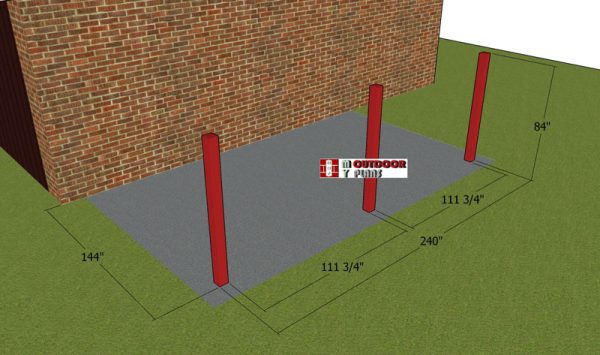
Laying-out-the-posts
The first step of the project is to determine the location for the wooden posts of the lean to patio cover. Properly laying out the posts for a patio cover ensures accurate placement, adequate support, and optimal spacing, guaranteeing a sturdy and well-balanced structure that will withstand the test of time. Use batter boards and string to layout the posts for the lean to attached patio cover.

Anchoring the posts of the anchor
You can set the posts in concrete or you can pour 3′ deep footings and use posts anchors. Considering this is a light outdoor project, you can set the posts to anchors. That is why, these plans are designed having that assumption in mind (concrete footing and post anchors).
Dig the holes and set the 14″ tube forms. Fill the tubes with concrete and set the post anchors. Make sure you let the concrete to dry out for a few day, before installing the posts into place. Use temporarily braces to secure the posts until you attach the plates.
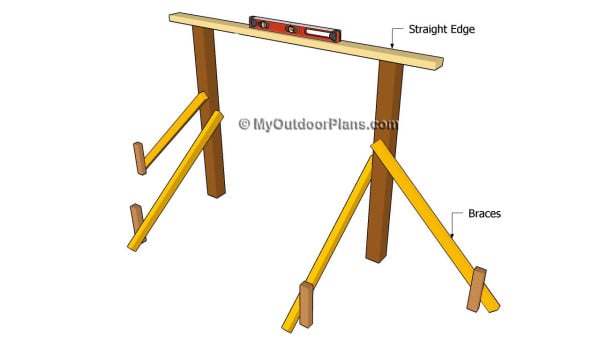
Installing the posts
After setting the posts into place, check if they are level and user a circular saw to make corrections. Notice the temporarily braces that hold the posts plumb. Leave the braces into place until you finish the assembly of the pergola. The temporarily braces will give support to the structure.

Top-support-beams
Use 6×8 lumber for the top beam of the lean to covered pergola. Mark the cut lines to the beams and make the notches to one end. Make parallel cuts inside the marked areas and then remove the excess with a hammer and a chisel.
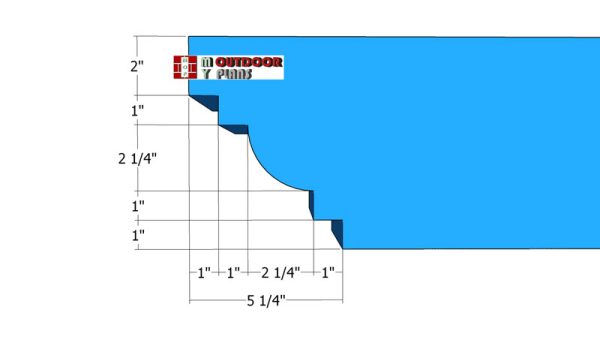
Decorative-end
Adding decorative cuts to the ends of wooden beams for a patio cover brings a touch of elegance and personalization, transforming ordinary structural elements into stunning architectural accents that enhance the overall beauty of your outdoor space. Follow the pattern in the diagram, if you like my design idea.

Fitting-the-top-support-beam
Continue the project by attaching the support beam to the top of the posts. See the 12″ overhangs on both sides. Plumb the posts and make sure the beams are horizontal. Fit two post to beam connectors to each post. Insert 1 1/2″ structural screws to lock the connectors together tightly. If you did everything correctly, the top beams should be perfectly horizontal.

Fitting-the-braces
Use 6×6 lumber for the braces. Make 45 degree cuts at both ends of the braces and then secure them into place with 5 1/2″ screws (at least 2 screws for joint). Make sure the corners are square before setting the braces into place.

Attaching-the-ledger-boards
Attaching a ledger board securely to the house wall is a crucial step in constructing a patio cover, as it provides stability, structural integrity, and a seamless connection between the cover and the existing structure, ensuring a safe and long-lasting installation. To install a ledger board for a patio cover, mark the desired location on the house wall, align it with wall studs, and secure it using lag screws or bolts.
Make sure you set the 2×10 ledger directly into the framing structure with 4 1/2″ lag screws with washers (or longer, depending to the house structure). Drill pilot holes and insert the screws to lock it into place tightly.
Insert at least 3 screws into each stud. Countersink the head of the screws, so you can set the rafters properly. Ensure the ledger board is level, plumb, and in compliance with local building codes for a safe and stable connection.
Building the lean to roof
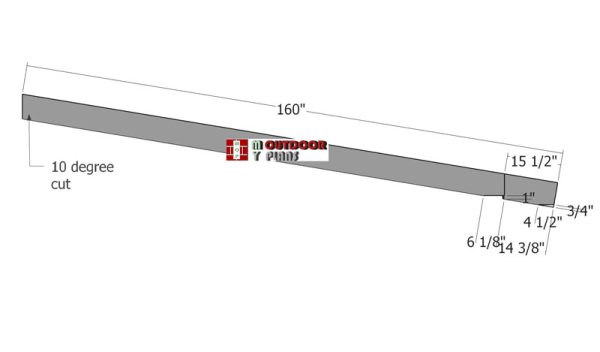
Rafters
Use 2×8 lumber for the rafters. Make a 10 degree cut to one end of the rafters. Mark the cut lines on the beams and then get the job done with a circular saw. Smooth the edges with sandpaper.
Mark the cut lines to the beams and make the notches with a circular saw.

Fitting-the-rafters
Fit the rafters to the attached carport, every 24″ on center. Fit the rafters to the ledger using rafter hangers and 1 1/2″ structural screws / nails (see next diagram for reference). Use rafter ties and 1 1/2″ structural screws to lock the rafters to the support beam, as well.
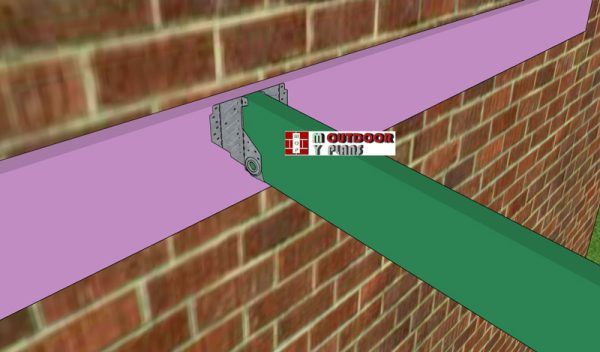
Rafter-hangers
See the rafter hangers needed to secure the rafters to the ledger beam. To secure rafters using rafter hangers, attach the hangers to the ledger board at designated locations, slide the rafters into the hangers, and secure them with appropriate fasteners. Follow the manufacturer’s instructions and adhere to local building codes for a safe and structurally sound installation.

Laying-the-roof-sheets
Use 3/4″ plywood for the roof sheeting. Lay the sheets and align the edges flush. Leave no gaps between the sheets. Insert 1 5/8″ screws to lock the sheets into place tightly, every 8″ along the framing.

Front-roof-trims
Fit the 1×8 trim to the front of the patio cover. Align the edges and insert 2″ into the ends of the raters, to lock the trim into place properly.

Side-roof-trims
Cut and fit the trims to the sides of the carport. See the 10 degree cuts to one end of the trims. Insert 2″ nails to secure the trims into place.

Fitting-the-roof-sheets
Begin by installing a layer of roofing underlayment, such as asphalt-saturated felt or synthetic underlayment. This acts as an additional barrier against moisture and provides extra protection for the roof. Next, nail a drip edge along the eaves of the roof to facilitate water runoff. The drip edge should extend over the fascia board.
Continue by fitting the starter course. Star at the eaves and install the starter course of shingles along the bottom edge of the roof. This helps create a secure base for the rest of the shingles and prevents wind uplift. Lay the shingles starting with the bottom edge and work your way up, overlapping each row of shingles. Follow the manufacturer’s instructions regarding the specific nailing pattern, overhang, and positioning of the shingles. Use roofing nails to secure the shingles, ensuring they are properly aligned and flat.

Installing-the-roof-flashing
To install wall roof flashing, clean the installation area and cut the flashing to size, ensuring proper overhang. Position the flashing against the wall, secure it with appropriate fasteners, and use roofing cement or sealant to reinforce the edges and seams for added water resistance.
Follow manufacturer instructions and adhere to local building codes to ensure a proper and effective installation that protects against water infiltration.
Finishing touches

12×20 lean to patio cover
You should take a look over my 24×24 garage plans and 16×24 garage plans, because you can easily add this carport to them. In this manner, you will have a garage with a side carport and shelter mare than one car.

12×20 lean to patio cover – side view
Basically, you should build an attached patio cover to effortlessly extend your living space, creating a seamless transition between indoor and outdoor areas while enjoying the comfort, shade, and added value it brings to your home.

12×20 lean to patio cover – front view
This project can be built in less than one week and it can also be used as a patio cover. I recommend you to read the local building codes before starting the project, so you make sure you comply with the local building codes. See all my Premium Plans in the Shop.
If you build this carport attached to the double garage, you will have a nice shaded area that will be perfect for a car or for woodworking outside. If you want to get the Premium Plans, see the GET PDF PLANS button bellow.
This woodworking project was about modern 12×20 patio cover plans free. If you want to see more outdoor plans, check out the rest of our step by step projects and follow the instructions to obtain a professional result.

